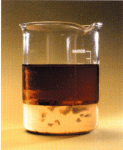Here's something in "
your neck of the woods" if your local shop doesn't carry it.
![Thumbs Up [thumbzup] [thumbzup]](https://www.steelsoldiers.com/images/smilies/icon_smile_thumzup.gif)
I haven't had experience with that particular product from Power Service, but in my reading the Power Service additives (except for winter treatment and biocide) are about as close to snake oil as you get can without damaging your engine. As an example,
here is an additive comparison that was done a while back for The Diesel Place forums by a lab (hosted on Jatonka's Deuce website). PRI-D didn't make the pool of tests for one reason or another, but they have
published their HFRR test results here. Opti-Lube XPD seems to be the best in the test (short of using biodiesel), however you will see in the PRI-D test result on the worst day PRI-D beats Power Service by a few points and on a good day by several hundred (heavily depends on original refinery output fuel quality - your neck of the woods seems to be the best place in the country to get diesel...).
The document talks about the finer points of maintaining Diesel without actually telling you why.
Yes, when you are "polishing" your fuel, you want to draw from the lowest possible point in the tank (and really scrape around any of the "gunk" [tar deposits] that are down there) to get out the water and any built up dead stuff (note the water at the bottom of a settled beaker, and algae blooms at the water/diesel boundary).

This will get the water, dirt, sediment, and tar globs out of the bottom of the tank. However you may recall from earlier posts in this thread that diesel is hygroscopic - meaning it will take in moisture creating an emulsion. The water separating filters will only take out liquid water, not entrained water (nearly evenly dispersed at the molecular level - think of it like Goretex "water not water vapor"). What ClearDiesel appears to claim to do is demulsify water from the fuel, loosens tar deposits, causes algae blooms to flocculate (clump). You still need a biocide to kill the algae this is growing at the fuel/water boundary, and you still need to draw off enough material from the bottom to remove ALL of the liquid water (with a coalescing filter), and enough of the diesel above the water to get any algae blooms that are still alive - this'll eat up the capacity of a fuel filter, which is why I recommend an over-sized one for "polishing" (extends the replacement interval). Then you need to treat the fuel with an algae inhibitor (doesn't last forever), and a fuel treatment that will inhibit rust (protecting the tank, also doesn't last forever), neutralizes metal poisoning of the fuel (doesn't last forever).
My rule of thumb is to polish the volume twice per cycle (whatever you decide your cycle is, for a 55Gallon drum, 110gallons would go through your pump and filters per cycle) so that you get a decent agitation of the fuel. Using an injection/dosing pump followed by a static mixer in the return pipe after the filter is probably overkill for most, but is the "right way" to mix the fuel additives (unless you have an empty tank it will never fully/correctly mix). Doing the volume twice lets you add your biocide and stabilizer at half the dose rate per pass, and gives the filter a longer time to capture the pollutants.
Keeping your fuel at a constant temperature above freezing (and the tank out of the sun) will keep the fuel from expanding and contracting which pulls in air from the outside like a diaphragm pump (from which the fuel can absorb moisture from the "new air"), and keeping the tank full will limit the amount of air that can enter and exit the tank during whatever temperature cycles the tank may endure.
Any additive that will:
- inhibit rust
- reduce metal poisoning of the fuel
- demulsify water
- cause algae to clump
- either retain or improve the lubricity of the fuel (NOT REDUCE)
AND an algae treatment that kills and keeps killed (either through sufficient initial dose, or smaller subsequent doses), is what I look for.
Hope this helps.


